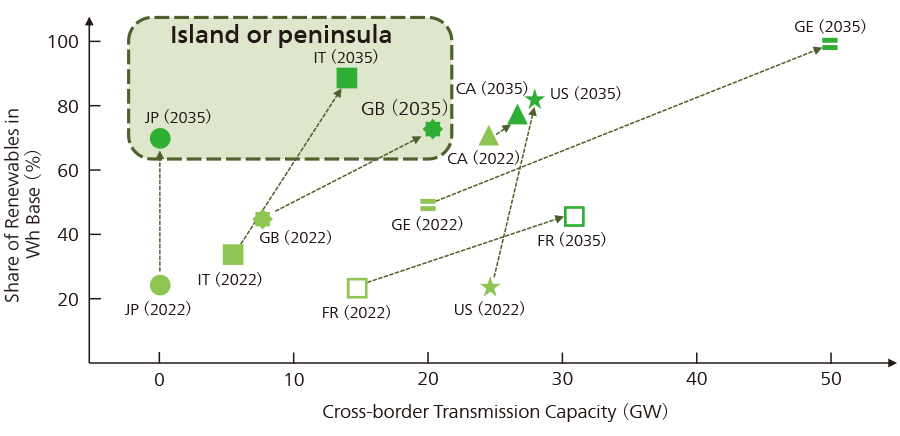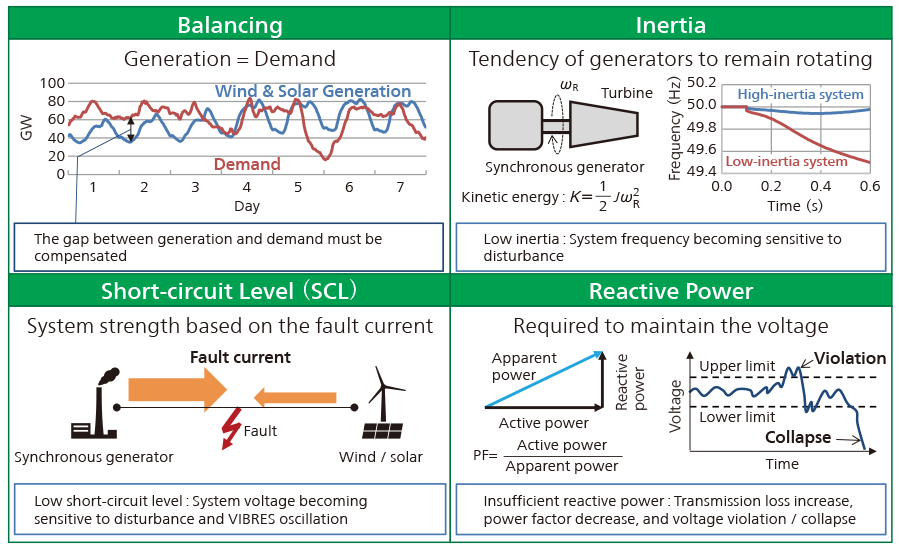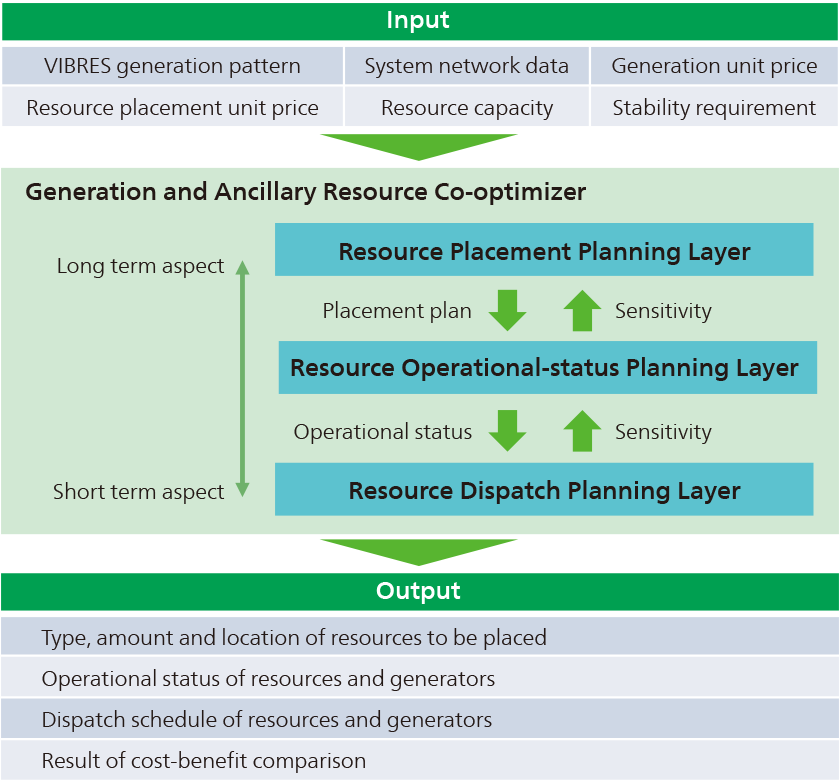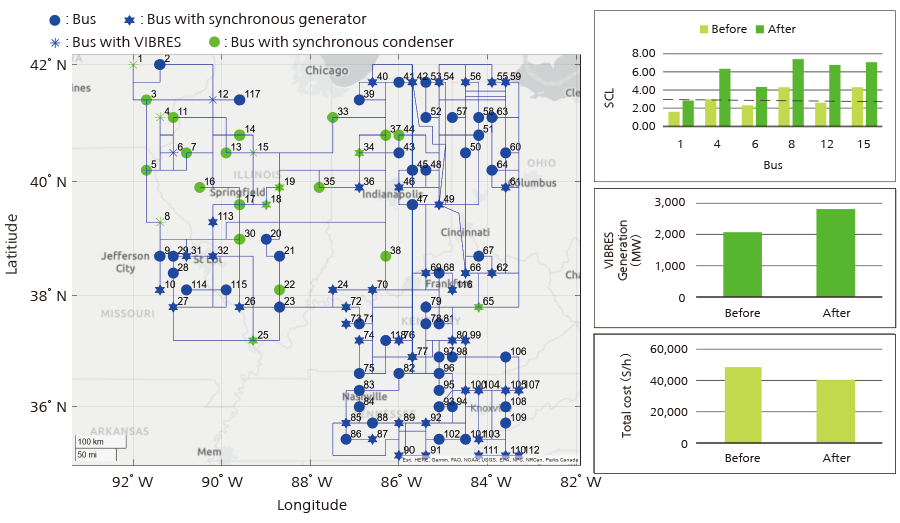Optimal Planning and Operation of Ancillary Resources to Maximize Renewable Generation in Future Power Systems
Highlight
Decarbonization of electricity generation and electrification of energy demand are essential to realizing a Net Zero society. Although conventional power systems have relied strongly on the synchronous generators of thermal power plants to maintain system stability, generation decarbonization is replacing synchronous generators with variable inverter-based renewable energy sources (VIBRES). Since this generation transition will bring stability challenges to future power systems, it is becoming crucial to manage ancillary services from various resources while satisfying the electricity demand requirements.
To optimize the scheduling of generation from generators and maximize renewable energy generation through planning/operation of ancillary resources at the same time, the Hitachi R&D Group is developing the Generation and Ancillary Resource Co-Optimizer. The concept of the Generation and Ancillary Resource Co-Optimizer consists of a hierarchical architecture to solve large and complex problems based on the decomposition method. The preliminary evaluation for optimally placing synchronous condensers demonstrated the effectiveness of the Generation and Ancillary Resource Co-Optimizer concept.
Introduction
Realizing a Net Zero society is an urgent challenge all over the world. Since decarbonization of electricity generation and electrification of energy demand are essential to achieving Net Zero, power systems play a key role in promoting decarbonization. Therefore, the Group of Seven (G7) has committed to predominantly decarbonizing their power systems by 2035(1). Figure 1 shows the power system transitions of G7 countries from 2022 to 2035. The metric for all countries moves up and to the right. This means that the growing share of renewables requires the expansion of cross-border capacity. From this viewpoint, Japan, UK, and Italy can be categorized in a group of countries that have relatively less cross-border capacity with external power systems due to their geography as either island or peninsula nations. These countries, which will have a high share of VIBRES with less cross-border capacity, are possibly facing advanced and challenging stability issues earlier than other countries.
Figure 2 shows examples of the stability issues aggravated by the generation transition:
- Balancing: The sum of electricity generation must be equal to the sum of electricity demand at all times in the power system. Since generation will fluctuate more due to the large share of VIBRES, balancing reserves as an ancillary service/resource is required to compensate for the gap between generation and demand.
- Inertia: This is the tendency of generators to remain rotating. The rotating mass consisting of the rotor and turbine of synchronous generators operating synchronously with each other forms the system inertia. On the other hand, VIBRES do not have such inherent inertia. While the system inertia decreases, as synchronous generators are replaced by VIBRES, the system frequency becomes more sensitive to disturbance. Inertia as an ancillary service/resource is required to maintain the system frequency.
- Short-Circuit Level (SCL): This is a system strength indicator based on the amount of fault current. Since the fault current capacity of synchronous generators is significantly greater than that of VIBRES, SCL decreases by replacing synchronous generators with VIBRES. It means that the system voltage is becoming sensitive to disturbance. Therefore, the behavior of VIBRES can be unstable under low SCL conditions. Fault current capacity as an ancillary service/resource is required to maintain the system strength.
- Reactive Power: This is required to maintain the system voltage. Some VIBRES have less capacity for reactive power than synchronous generators. If the reactive power capacity of the system is insufficient, it causes transmission loss increase, power factor decrease, voltage violation, and voltage collapse. Reactive power capacity as an ancillary service/resource is required to maintain the system voltage and improve the efficiency of system operation.
Figure 1—Power System Transition of G7 Countries from 2022 to 2035 JP: Japan, IT: Italy, GB: Great Britain, CA: Canada, US: United States, GE: Germany, FR: France The metric for all countries moves up and to the right. The growing share of renewables requires the expansion of cross-border capacity.
JP: Japan, IT: Italy, GB: Great Britain, CA: Canada, US: United States, GE: Germany, FR: France The metric for all countries moves up and to the right. The growing share of renewables requires the expansion of cross-border capacity.
Figure 2—Power System Stability Issues 𝐽: Moment of inertia, 𝜔_R: Rated angular velocity, VIBRES: Variable Inverter-based Renewable Energy Sources, PF: Power FactorThe power system is becoming unstable due to the penetration of VIBRES.
𝐽: Moment of inertia, 𝜔_R: Rated angular velocity, VIBRES: Variable Inverter-based Renewable Energy Sources, PF: Power FactorThe power system is becoming unstable due to the penetration of VIBRES.
Generation and Ancillary Resource Co-Optimizer
Renewable energy generation cannot be maximized without managing power system stability by using appropriate ancillary services/resources in the future power system. Therefore, we are developing a new solution called the Generation and Ancillary Resource Co-Optimizer to optimize the scheduling of generation from generators and planning/operation of ancillary resources at the same time.
Basic Concept
Figure 3—Generation and Ancillary Resource Co-Optimizer Concept The Generation and Ancillary Resource Co-Optimizer mainly consists of three planning layers to optimize the scheduling of generation from generators and planning/operation of ancillary resources at the same time.
The Generation and Ancillary Resource Co-Optimizer mainly consists of three planning layers to optimize the scheduling of generation from generators and planning/operation of ancillary resources at the same time.
Figure 3 shows the basic concept of the Generation and Ancillary Resource Co-Optimizer. Based on input data such as VIBRES generation patterns, system network data, generation unit prices, resource placement unit prices, resource capacity, stability requirements and so on, it provides the following information as output:
- type, amount, and location of ancillary resources to be placed
- operational status of ancillary resources and generators
- dispatch schedule of ancillary resources and generators
- result of cost-benefit comparison
The Generation and Ancillary Resource Co-Optimizer mainly consists of three planning layers: resource placement planning layer, resource status planning layer, and resource dispatch planning layer. These layers calculate different problems iteratively and interactively with each other.
- The resource placement planning layer: This layer calculates the optimal placement plan for ancillary resources to minimize the resource placement costs based on the given unit prices and VIBRES generation patterns. The calculation result provides the type, amount, and location of ancillary resources to be placed.
- The resource operational-status planning layer: This layer calculates the optimal operational-status of generators and ancillary resources such as unit commitment and maintenance schedule to minimize the costs affected by the operational status based on the given generation unit prices, VIBRES generation patterns, and the placement plan of ancillary resources.
- The resource dispatch planning layer: This layer calculates the optimal dispatch of generators and ancillary resources to minimize the operational costs based on the given generation unit prices, VIBRES generation patterns, operational status of generators and ancillary resources, and detailed system network model.
The calculation results of the upper layers become the input of the lower layers. On the other hand, the sensitivity of the constraints against the costs obtained from the lower layers generate additional constraints to the upper layers for reflecting the critical conditions of the lower layers.
Preliminary Evaluation
Figure 4—Evaluation Result SCL: Short-Circuit LevelThe left-hand diagram presents the location of the synchronous condenser to be placed. The right-hand charts present the SCL values at buses with VIBRES, VIBRES generation, and total cost.
SCL: Short-Circuit LevelThe left-hand diagram presents the location of the synchronous condenser to be placed. The right-hand charts present the SCL values at buses with VIBRES, VIBRES generation, and total cost.
As a preliminary evaluation, we calculated the optimal placement of synchronous condensers by using the prototype of the Generation and Ancillary Resource Co-Optimizer. This prototype consists of the resource placement planning layer and resource dispatch planning layer. The objective is to minimize the total cost including the generation costs of generators and placement costs of synchronous condensers while satisfying the required SCL and network constraints such as power flow equation and transmission asset capacity. The synchronous condenser is modelled as an ancillary resource that has the fault current capacity and reactive power capacity in this evaluation.
Figure 4 shows the evaluation results. The left-hand diagram presents the location of the synchronous condenser to be placed. The right-hand charts present the SCL values at buses with VIBRES, VIBRES generation, and total cost. From these results, we can see that:
- SCL values increased by the contribution from the fault current capacity of the synchronous condensers
- Total generation from VIBRES also increased by the contribution from the fault current capacity and reactive power capacity of the synchronous condensers
- The total cost decreased because the increasing of VIBRES generation reduced the entire generation costs
These results show that the Generation and Ancillary Resource Co-Optimizer can provide a cost-effective plan based on the optimization of the scheduling of generation and planning/operation of ancillary resources at the same time.
Conclusions
Appropriate management of ancillary services/resources is crucial to maximizing the integration of and generation from VIBRES while maintaining power system stability.
The Hitachi R&D Group has been tackling this challenge globally and developing technologies to solve this complex problem in order to realize the transition to green energy.



